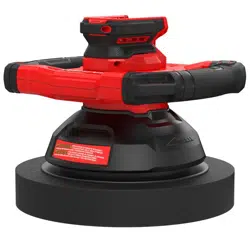Loading ...
Loading ...
Loading ...

English
6
stopping flying debris generated by various operations.
The dust mask or respirator must be capable of
filtrating particles generated by your operation.
Prolonged exposure to high intensity noise may cause
hearingloss.
h ) Keep bystanders a safe distance away from work
area. Anyone entering the work area must wear
personal protective equipment. Fragments of
workpiece or of a broken accessory may fly away and
cause injury beyond immediate area ofoperation.
i ) Never lay the power tool down until the accessory
has come to a complete stop. The spinning
accessory may grab the surface and pull the power tool
out of yourcontrol.
j ) Hold unit firmly while using, do not drop. If
dropped while running it could land on its pad
and the handle will spin and be difficult to get a
hold of. However, if it does, do not attempt to grab by
hand, gently tip the unit over using a sturdy board or
broom and then the handle will be more easilygrasped.
k ) Do not run the power tool while carrying it at your
side. Accidental contact with the spinning accessory
could snag your clothing, pulling the accessory into
yourbody.
l ) Regularly clean the power tool’s air vents. The
motor’s fan will draw the dust inside the housing and
excessive accumulation of powdered metal may cause
electricalhazards.
m ) Do not operate the power tool near flammable
materials. Sparks could ignite thesematerials.
n ) Do not use accessories that require liquid
coolants. Using water or other liquid coolants may
result in electrocution orshock.
FURTHER SAFETY INSTRUCTIONS FOR ALL
OPERATIONS
Causes and Operator Prevention
ofKickback
Kickback is a sudden reaction to a pinched or snagged rotating
wheel, backing pad, brush or any other accessory. Pinching or
snagging causes rapid stalling of the rotating accessory which
in turn causes the uncontrolled power tool to be forced in the
direction opposite of the accessory’s rotation at the point of
thebinding.
For example, if an abrasive wheel is snagged or pinched by the
workpiece, the edge of the wheel that is entering into the pinch
point can dig into the surface of the material causing the wheel
to climb out or kick out. The wheel may either jump toward or
away from the operator, depending on direction of the wheel’s
movement at the point of pinching. Abrasive wheels may also
break under theseconditions.
Kickback is the result of power tool misuse and/or incorrect
operating procedures or conditions and can be avoided by
taking proper precautions as given below:
a ) Maintain a firm grip on the power tool and
position your body and arm to allow you to resist
ADDITIONAL SPECIFIC SAFETY RULES
Safety Instructions for All Operations
a ) This power tool is intended to function as a
polisher. Read all safety warnings, instructions,
illustrations and specifications provided with
this power tool. Failure to follow all instructions
listed below may result in electric shock, fire and/or
seriousinjury.
b ) Operations such as grinding, sanding, wire
brushing or cutting‑off are not recommended to
be performed with this power tool. Operations for
which the power tool was not designed may create a
hazard and cause personalinjury.
c ) Do not use accessories which are not specifically
designed and recommended by the tool
manufacturer. Just because the accessory can
be attached to your power tool, it does not assure
safeoperation.
d ) The rated speed of the accessory must be at least
equal to the maximum speed marked on the
power tool. Accessories running faster than their rated
speed can break and flyapart.
e ) The outside diameter and the thickness of your
accessory must be within the capacity rating of
your power tool. Incorrectly sized accessories cannot
be adequately guarded orcontrolled.
f ) Do not use a damaged accessory. Before each use
inspect the accessory such as polishing pad for
chips and cracks, backing pad for cracks, tear or
excess wear, wire brush for loose or cracked wires.
If power tool or accessory is dropped, inspect
for damage or install an undamaged accessory.
After inspecting and installing an accessory,
position yourself and bystanders away from the
plane of the rotating accessory and run the power
tool at maximum no‑load speed for one minute.
Damaged accessories will normally break apart during
this testtime.
g ) Wear personal protective equipment. Depending
on application, use face shield, safety goggles or
safety glasses. As appropriate, wear dust mask,
hearing protectors, gloves and workshop apron
capable of stopping small abrasive or workpiece
fragments. The eye protection must be capable of
• Use the appropriate dust extractor vacuum to remove
the vast majority of static and airborne dust. Failure
to remove static and airborne dust could contaminate the
working environment or pose an increased health risk to
the operator and those in closeproximity.
• Air vents often cover moving parts and should be
avoided. Loose clothes, jewelry or long hair can be caught
in movingparts.
CAUTION: When not in use, place tool on its side
on a stable surface where it will not cause a
tripping or falling hazard. Some tools with large
battery packs will stand upright on the battery pack
but may be easily knockedover.
Loading ...
Loading ...
Loading ...
